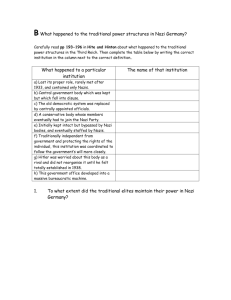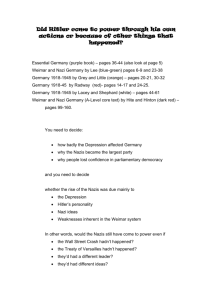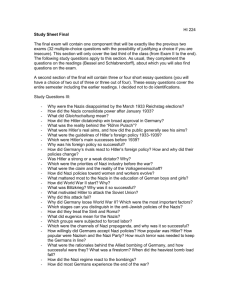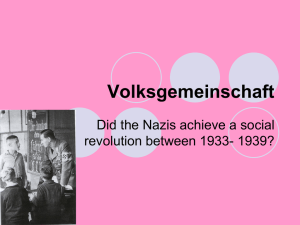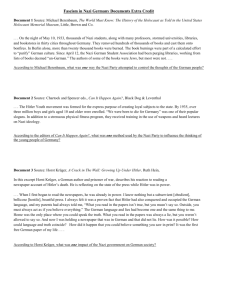Nazi Germany 1934-1945 Part 2 Control and
advertisement
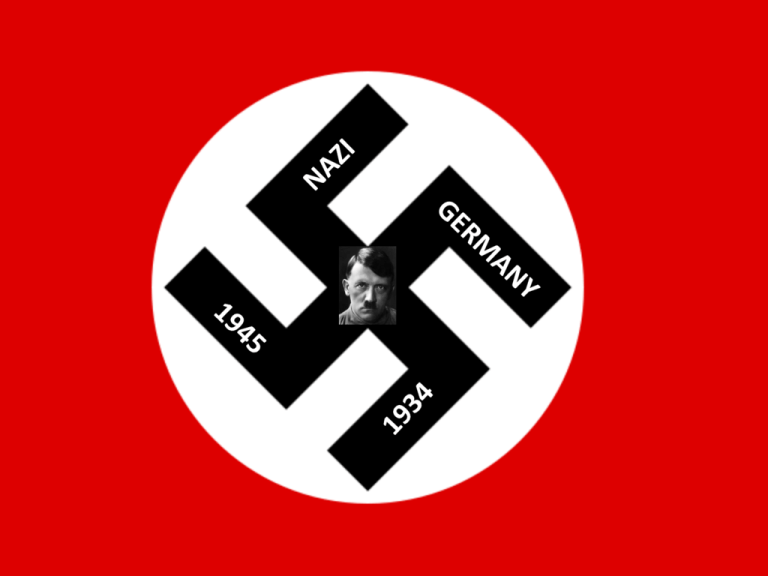
Unit 2D: Germany, 1919 – 1945 Source based exam. 1hr 45mins. 60marks total. 40% of final grade. Topics; • • • • Control and Opposition German Economy and Society Race and Youth Culture and Propaganda Understanding the Assessment Assessment • Unit 2D: Germany, 1919 – 1945 • Written Paper – 1 hour 45 mins – 60 marks – • 40% – Enquiry in Depth Learning Objectives • What will we be studying? Part 2: Control and Opposition Key issue: How effectively did the Nazis control Germany in the years 1933–1945? • The nature of the totalitarian state; the abolition of freedom, individual liberties and trade unions • The nature of continuing opposition and resistance within the Third Reich • The White Rose movement, the work of individuals such as Niemöller and Bonhoeffer • The opposition of the military, the Stauffenberg bomb plot. Part 3: German Economy and Society Key issue: How much change did the Nazis bring about in German society? • Changes in policies and attitudes to the role of women in German society, 1933–1945 • Nazi policies and attitudes towards religion and responses to this within Germany • Nazism as social revolution and the impact of the regime on different social classes. Key issue: How successful were the Nazis in rebuilding the German economy? • The development of the economy and employment patterns in the 1930s • Economic planning: preparation for war • The response of the German people to economic changes in the 1930s • The impact of the war upon the German economy and society. Part 4: Race and Youth Key issue: How successful were the Nazis in influencing young people? • The appeal of Nazism to youth; the role of youth in National Socialism • Youth movements in Nazi Germany • Education in German schools and universities as an instrument of propaganda • The extent and nature of youth resistance. Key issue: How important in Germany were Nazis’ ideas on race? • Nazi ideas: the belief in Aryan supremacy and the master race • Racism in the Nazi state, the treatment of minority groups in society • The persecution of the Jews and the Final Solution • Reactions in Germany to these developments from different individuals and groups. Part 5: Culture and Propaganda Key issue: How did the Nazis change the cultural climate of Weimar Germany? • The cultural climate of Weimar Germany as represented in entertainment and the arts, 1919–1933 • Reactions and responses to ‘Weimar culture’ • The effects of the Nazi regime on the cultural climate of Germany, 1933–1945 • The role and success of Nazi propaganda in sport, leisure, the media, entertainment and the arts • The cult of the Führer. Learning Objective • To understand the position of Germany in 1934. Context • Where are we by the beginning of August 1934? • Hitler is Chancellor of Germany, second only to the President. • The Nazi Party is the largest party in the Reichstag. • The Communist party has been banned. • The Army supports Hitler. • The SS are his own private army. • Hitler can make any laws he needs without opposition. What barrier remained to Hitler? Paul Ludwig Hans Anton von Beneckendorff und von Hindenburg 1847 – 1934 was a Prussian-German field marshal, statesman, and politician, and served as the second President of Germany from 1925 to 1934. Hindenburg enjoyed a long career in the Prussian Army, retiring in 1911. He was recalled at the outbreak of World War I, and first came to national attention, at the age of 66, as the victor at Tannenberg in 1914. Hindenburg retired again in 1919, but returned to public life one more time in 1925 to be elected as the second President of Germany. Paul von Hindenburg dies and Hitler becomes president as well as chancellor. 2nd August, 1934 What effect will this have on Hitler? Following Hindenburg's death, Hitler merged the presidency with the office of Chancellor under the title of Leader and Chancellor making himself Germany's Head of State and Head of government. This action effectively removed the last remedy by which Hitler could be legally removed from office—and with it, all institutional checks and balances on his power. What has Hitler succeeded in creating? Hitler had a plebiscite held on 19 August 1934, in which the German people were asked if they approved of Hitler merging the two offices. The Ja vote amounted to 90% of the vote. Dictatorship “I will render unconditional obedience to the Fuhrer of the German Reich and people, Adolf Hitler, the supreme commander of the armed forces, and will be ready as a brave soldier to stake my life at any time for this oath.” Learning Objective • To understand what totalitarian means. • To assess how much Nazi Germany was a totalitarian regime. • How would you explain what a totalitarian regime is? Totalitarianism • (or totalitarian rule) is a political system where the state recognizes no limits to its authority and strives to regulate every aspect of public and private life wherever feasible. • Totalitarian regimes stay in political power through propaganda, disseminated through the state-controlled mass media, a single party that is often marked by personality cultism, control over the economy, regulation and restriction of speech,mass surveillance, and widespread use of terror. Learning Objective • To identify the groups who would need to be controlled. • To consider methods used for control. Enemies of the Reich • • • • • • • Communists Social Democrats Jews Trade Unionists. Work Shy Homosexuals Gypsies • Germans who bought from Jews • Pacifists • Radical Christian Organisation • Anyone who criticised Hitler or the Nazi Party. What methods would you use to control the “people”? Key “Terror is the Quote best political weapon for nothing drives people harder than a fear of sudden death.” Learning Objective • To understand what a police state is. • To evaluate how successful Hitler was in creating a police state The People The SS The Nazi Police State Concentration Camps The Gestapo SS were responsible for running the concentration camps. Secret police would spy on and arrest enemies of the state. The People The SS Everyone was scared of being arrested by the Gestapo and being put in a concentration camp. The Nazi Police State Concentration Camps The Gestapo The Gestapo Geheime Staatspolizei The SS Schutzstaffel The Police State • Both the Gestapo and the SS were run by Heinrich Himmler. The Police State • The Gestapo employed an army of spies who would inform on people. • They tapped phones, intercepted mail and received denunciations from informers. Had strong local structure – Gauleiters responsible for “Gau”, divided into towns, streets & blocks. • Activists were ‘eyes & ears’ of Party. • Reports compiled on any form of opposition – telling anti-Hitler jokes, refusing to give Hitler salute, not flying Nazi flag. The Police State • The SS grew from a personal protection force for Hitler into a huge organisation in charge of the concentration camps, spying, army regiments and foreign soldiers. What were concentration camps? • Began as temporary prisons in disused warehouse or temporary enclosures for Nazi opposition. • Political opponents & ‘asocials’ imprisoned. • Slave labour used to manufacture weapons or work on public works schemes. • The number of camps quadrupled between 1939 and 1942 to 300+, as slave-labourers from across Europe; Jews, political prisoners, criminals, homosexuals, gypsies, the mentally ill and others were incarcerated. • Some became “death” camps as part of the Final Solution. Nazi Camps in Greater Germany 1944 Nazi Camps in Europe January 1944 How did the Police State work? You are imprisoned for up to six months doing hard physical labour. You are handed over to the SS who run the concentration camps. By signing this form you are giving your consent to be put into a concentration camp. When you are released you tell everybody what has happened to you Gestapo Spies inform on you Fear You are woken up by the Gestapo at 1 am in the morning and told that you have 5 minutes to pack your bags. Days or maybe weeks later you are interviewed and asked to sign form D11 You are arrested and thrown into a cell at the police station • A list of German women who were still purchasing goods from Jewish shops. • Printed to scare or terrorise other people into not buying from the Jews. Nazi Law • Existing police forces, courts, laws remained in force. • Police put under command of Himmler & the SS. • Judges swore oath of loyalty or were replaced by Nazi supporters. • People’s Court & Special Court tried political opponents & traitors. • These abolished the right of trial before imprisonment. • By 1939, 162,000 Germans imprisoned without trial, 500 sentenced to death. How effective was the Police State? • Everyone knew someone who knew someone else who had been in a concentration camp. • Favourite joke amongst Germans at this time: A man goes to the Dentist. The Dentist says: ‘Open Wide.’ The man sits up and says: ‘Not in front of a stranger.’ • Favourite Saying amongst Germans: ‘Speak through a Flower.’ • 800,000 Germans were imprisoned from 1933 – 1945 as ‘Enemies of the State.’ • 500,000 were executed by being shot in the neck. Learning Objective • To understand how the Nazi’s worked to control workers. Who organises strike action? Trade Unions Trade Unions Thinking; • How would workers benefit from trade unions? • Why might Trade Unions be seen as a threat? Deutsche Arbeitsfront • What does this mean? German Labour Front • Or the DAF. • Theoretically, the DAF existed to act as a medium through which workers and owners could mutually represent their interests. DAF • Robert Ley • Head of the DAF from its creation in April 1933. Evaluating the DAF Trade Unions POSITIVES NEGATIVES • To ‘protect’ those in work, the German Labour Front was set up. • The DAF took the role of trade unions.. • Workers could not be sacked on the spot. • Government labour exchanges could arrange for a new job if someone did leave his employment. • The average factory worker was earning 10 times more than those on dole money. • All other Trade unions had been banned. • A worker could not leave his job without the government’s permission. • Only government labour exchanges could arrange for a new job. • The DAF increased the number of hours worked from 60 to 72 per week (including overtime) by 1939. • Strikes were outlawed. • Any complaining was potentially dangerous. Remember what happened to the Work shy! Learning Objective • To understand how the Nazi’s worked to control the church. The Church • Why would the church pose a threat to the Nazi regime? What does this suggest is the solution sought by the Nazi’s? A Nazi Church? The Church • Many leading Nazis were anti-Christian but unwilling to provoke conflict with Church. • In June 1933, Catholic Church signed ‘Concordat’ (an understanding). • The Protestant Churches combined into a pro-Nazi Reich Church, ‘The swastika on our breast and the cross in our hearts”. • Those churches who remained independent were called “Confessing Churches” but were subject to persecution and harassment. What was the Concordat? The Pope signed a Concordat with Hitler. He agreed not to interfere in Nazi politics if the Church was left alone. The “Reich Church” • In 1936, the Reich Church was created. This did not have the Christian cross as its symbol but the swastika. The Bible was replaced by "Mein Kampf" which was placed on the altar. By it was a sword. Only invited Nazis were allowed to give sermons in a Reich Church. The “Reich Church” Reich Church symbol Did the Nazi’s isolate the Church? • In 1937, the pope, Pius XI, issued his "Mit brennender Sorge" statement ("With burning anxiety") over what was going on in Germany. • Martin Niemoller became a figure of resistance from the Protestant Church and was arrested in 1937. Martin Niemoller First they came for the communists, and I didn't speak out because I wasn't a communist. Then they came for the trade unionists, and I didn't speak out because I wasn't a trade unionist. Then they came for the Jews, and I didn't speak out because I wasn't a Jew. Then they came for me and there was no one left to speak out for me. How useful to a Historian would this source be?

